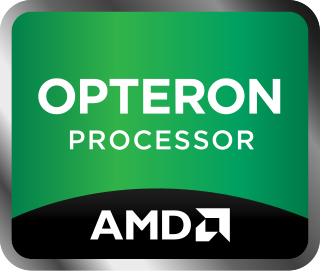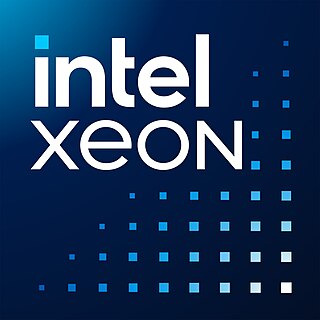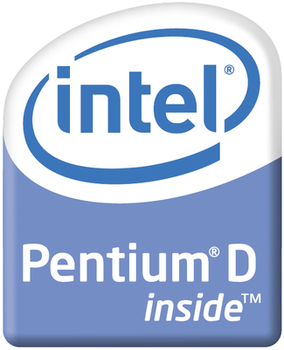Related Research Articles

Advanced Micro Devices, Inc. (AMD) is an American multinational corporation and semiconductor company based in Santa Clara, California, that develops computer processors and related technologies for business and consumer markets.

Opteron is AMD's x86 former server and workstation processor line, and was the first processor which supported the AMD64 instruction set architecture. It was released on April 22, 2003, with the SledgeHammer core (K8) and was intended to compete in the server and workstation markets, particularly in the same segment as the Intel Xeon processor. Processors based on the AMD K10 microarchitecture were announced on September 10, 2007, featuring a new quad-core configuration. The last released Opteron CPUs are the Piledriver-based Opteron 4300 and 6300 series processors, codenamed "Seoul" and "Abu Dhabi" respectively.

The Athlon 64 is a ninth-generation, AMD64-architecture microprocessor produced by Advanced Micro Devices (AMD), released on September 23, 2003. It is the third processor to bear the name Athlon, and the immediate successor to the Athlon XP. The Athlon 64 was the second processor to implement the AMD64 architecture and the first 64-bit processor targeted at the average consumer. Variants of the Athlon 64 have been produced for Socket 754, Socket 939, Socket 940, and Socket AM2. It was AMD's primary consumer CPU, and primarily competed with Intel's Pentium 4, especially the Prescott and Cedar Mill core revisions.

Xeon is a brand of x86 microprocessors designed, manufactured, and marketed by Intel, targeted at the non-consumer workstation, server, and embedded markets. It was introduced in June 1998. Xeon processors are based on the same architecture as regular desktop-grade CPUs, but have advanced features such as support for error correction code (ECC) memory, higher core counts, more PCI Express lanes, support for larger amounts of RAM, larger cache memory and extra provision for enterprise-grade reliability, availability and serviceability (RAS) features responsible for handling hardware exceptions through the Machine Check Architecture (MCA). They are often capable of safely continuing execution where a normal processor cannot due to these extra RAS features, depending on the type and severity of the machine-check exception (MCE). Some also support multi-socket systems with two, four, or eight sockets through use of the Ultra Path Interconnect (UPI) bus, which replaced the older QuickPath Interconnect (QPI) bus.

The land grid array (LGA) is a type of surface-mount packaging for integrated circuits (ICs) that is notable for having the pins on the socket — as opposed to pins on the integrated circuit, known as a pin grid array (PGA). An LGA can be electrically connected to a printed circuit board (PCB) either by the use of a socket or by soldering directly to the board.

The nForce4 is a motherboard chipset released by Nvidia in October 2004. The chipset supports AMD 64-bit processors and Intel Pentium 4 LGA 775 processors.

Socket 939 is a CPU socket released by AMD in June 2004 to supersede the previous Socket 754 for Athlon 64 processors. Socket 939 was succeeded by Socket AM2 in May 2006. It was the second socket designed for AMD's AMD64 range of processors.

Pentium D is a range of desktop 64-bit x86-64 processors based on the NetBurst microarchitecture, which is the dual-core variant of the Pentium 4 manufactured by Intel. Each CPU comprised two cores. The brand's first processor, codenamed Smithfield and manufactured on the 90 nm process, was released on May 25, 2005, followed by the 65 nm Presler nine months later. The core implementation on the 90 nm "Smithfield" and later 65 nm "Presler" are designed differently but are functionally the same. The 90 nm "Smithfield" contains a single die, with two adjoined but functionally separate CPU cores cut from the same wafer. The later 65 nm "Presler" utilized a multi-chip module package, where two discrete dies each containing a single core reside on the CPU substrate. Neither the 90nm "Smithfield" nor the 65 nm "Presler" were capable of direct core to core communication, relying instead on the northbridge link to send information between the 2 cores.
AMD Cool'n'Quiet is a CPU dynamic frequency scaling and power saving technology introduced by AMD with its Athlon XP processor line. It works by reducing the processor's clock rate and voltage when the processor is idle. The aim of this technology is to reduce overall power consumption and lower heat generation, allowing for slower cooling fan operation. The objectives of cooler and quieter result in the name Cool'n'Quiet. The technology is similar to Intel's SpeedStep and AMD's own PowerNow!, which were developed with the aim of increasing laptop battery life by reducing power consumption.
In the fields of digital electronics and computer hardware, multi-channel memory architecture is a technology that increases the data transfer rate between the DRAM memory and the memory controller by adding more channels of communication between them. Theoretically, this multiplies the data rate by exactly the number of channels present. Dual-channel memory employs two channels. The technique goes back as far as the 1960s having been used in IBM System/360 Model 91 and in CDC 6600.
The Intel Core microarchitecture is a multi-core processor microarchitecture launched by Intel in mid-2006. It is a major evolution over the Yonah, the previous iteration of the P6 microarchitecture series which started in 1995 with Pentium Pro. It also replaced the NetBurst microarchitecture, which suffered from high power consumption and heat intensity due to an inefficient pipeline designed for high clock rate. In early 2004 the new version of NetBurst (Prescott) needed very high power to reach the clocks it needed for competitive performance, making it unsuitable for the shift to dual/multi-core CPUs. On May 7, 2004 Intel confirmed the cancellation of the next NetBurst, Tejas and Jayhawk. Intel had been developing Merom, the 64-bit evolution of the Pentium M, since 2001, and decided to expand it to all market segments, replacing NetBurst in desktop computers and servers. It inherited from Pentium M the choice of a short and efficient pipeline, delivering superior performance despite not reaching the high clocks of NetBurst.
The AMD Family 10h, or K10, is a microprocessor microarchitecture by AMD based on the K8 microarchitecture. The first third-generation Opteron products for servers were launched on September 10, 2007, with the Phenom processors for desktops following and launching on November 11, 2007 as the immediate successors to the K8 series of processors.

Socket F is a CPU socket designed by AMD for its Opteron line of CPUs released on August 15, 2006. In 2010 Socket F was replaced by Socket C32 for entry-level servers and Socket G34 for high-end servers.
The Xpress 3200 is a revision of the Xpress 200 computer chipset released by ATI. The chipset supports AMD64 processors for Socket 939 and Socket AM2.

AMD Live! is the name of AMD's initiative in 2005 aimed at gathering the support of professional musicians and other media producers behind its hardware products. The primary focus of this initiative was the Opteron server- and workstation-class central processing units (CPUs).
The nForce 600 chipset was released in the first half of November 2006, coinciding with the GeForce 8 series launch on November 8, 2006. The nForce 600 supports Intel's LGA 775 socket and AMD's Quad FX platform and replaces the nForce 500 series.
The AMD 700 chipset series is a set of chipsets designed by ATI for AMD Phenom processors to be sold under the AMD brand. Several members were launched in the end of 2007 and the first half of 2008, others launched throughout the rest of 2008.
The AMD Bulldozer Family 15h is a microprocessor microarchitecture for the FX and Opteron line of processors, developed by AMD for the desktop and server markets. Bulldozer is the codename for this family of microarchitectures. It was released on October 12, 2011, as the successor to the K10 microarchitecture.
AMD Piledriver Family 15h is a microarchitecture developed by AMD as the second-generation successor to Bulldozer. It targets desktop, mobile and server markets. It is used for the AMD Accelerated Processing Unit, AMD FX, and the Opteron line of processors.
References
- ↑ Hachman, Mark (2006-06-01). "AMD Announces Dual-Socket, Dual-Core '4x4' Platform". ExtremeTech. Archived from the original on 4 November 2007. Retrieved 2007-10-02.
- ↑ Stokes, John (2006-06-02). "AMD hitches wagon to a HyperTransport-powered 4x4 and K8L". Ars Technica. Archived from the original on 30 September 2007. Retrieved 2007-10-02.
- ↑ Goodin, Dan (2006-11-15). "AMD, Intel: Who's Zooming Who?". Wired Magazine . Retrieved 2007-10-02.
- ↑ "AMD Names the Next PC Computing Thrill Ride: The AMD Phenom Processor" (Press release). Advanced Micro Devices. 2007-05-14. Archived from the original on 11 October 2007. Retrieved 2007-10-02.
- ↑ "AMD Quad FX Platform with Dual Socket Direct Connect Architecture Redefines High-End Computing for Megatasking Enthusiasts" (Press release). Advanced Micro Devices. 2006-11-30. Archived from the original on 13 October 2007. Retrieved 2007-10-02.
- ↑ Wasson, Scott (2006-12-01). "AMD's Quad FX platform: AMD decides to socket to 'em". The Tech Report . Retrieved 2007-06-11.
- ↑ Brown, Rich; Takahashi, Dean (2006-06-01). "AMD's introduces new CPU architectures, Socket 4x4 chipset". CNET Networks. Archived from the original on 2006-08-13. Retrieved 2007-10-02.
- ↑ "AMD Puts Pressure On Intel In PC Gaming With New Socket For Two Dual-Core Processors". San Jose Mercury News . 2006-06-01. Archived from the original on 29 September 2007. Retrieved 2007-10-02.
- ↑ Wasson, Scott (2006-07-26). "Dual-CPU kits for '4x4' to sell for under a grand". The Tech Report . Retrieved 2007-10-02.
- 1 2 Gruener, Wolfgang (2007-05-10). "AMD demos 8-core Agena FX enthusiast PC, stream processing". TG Daily. Archived from the original on 2008-05-31. Retrieved 2007-10-02.
- ↑ Ames, Ben (2006-11-14). "Intel Launches Quad-Core Chips". PC World. Archived from the original on 31 October 2007. Retrieved 2007-10-02.
- ↑ Demerjian, Charlie (2007-01-14). "Intel pulls wool over eyes with "gaming rig"". The Inquirer. Archived from the original on 2007-10-11. Retrieved 2007-10-02.
{{cite news}}: CS1 maint: unfit URL (link) - ↑ "Intel Developer Forum Day 1 News Disclosures From Beijing" (Press release). Intel. 2007-04-17. Archived from the original on 19 September 2007. Retrieved 2007-10-02.
- 1 2 3 Shimpi, Anand Lal (2006-11-30). "AMD's Quad FX: Technically Quad Core". AnandTech. Archived from the original on 2 October 2007. Retrieved 2007-10-02.
- ↑ Morris, James (2007-01-18). "AMD QuadFX pushed to the limit... and beyond". Hexus.net. Retrieved 2007-10-02.
- ↑ Gavrichenkov, Ilya (2006-11-29). "Quad-Core from AMD: Quad FX Platform Review". X-bit labs. Archived from the original on 2007-10-13. Retrieved 2007-10-02.
- ↑ Abazovic, Fuad (2007-03-23). "Athlon FX 76 cancelled". Fudzilla. Archived from the original on 2007-10-26. Retrieved 2007-10-02.
- ↑ Valich, Theo (2006-10-26). "AMD's 4x4 supports four graphic cards". The Inquirer. Archived from the original on 2007-10-09. Retrieved 2007-10-02.
{{cite news}}: CS1 maint: unfit URL (link) - ↑ Valich, Theo (2006-11-20). "AMD partners outraged at 4x4 Asus exclusive". The Inquirer. Archived from the original on 2007-10-23. Retrieved 2007-10-02.
{{cite news}}: CS1 maint: unfit URL (link) - ↑ Huynh, Anh (2 February 2007). "AMD Opteron 2200-series Works in Quad FX Motherboards". DailyTech. Archived from the original on 27 September 2007. Retrieved 2 October 2007.
- 1 2 "Informacion confidencial de ATI" (in Spanish). ChileHardWare. 2006-10-06. Archived from the original on 2007-01-07. Retrieved 2007-10-02.
- ↑ Ferret, Wily (2007-09-12). "AMD no longer FASN8ted". The Inquirer. Archived from the original on April 9, 2008. Retrieved 2007-10-02.
{{cite news}}: CS1 maint: unfit URL (link) - ↑ Valich, Theo (2007-10-02). "AMD goes on the slide". The Inquirer. Archived from the original on 5 October 2007. Retrieved 2007-10-02.
{{cite news}}: CS1 maint: unfit URL (link) - ↑ Cheung, Humphrey (2007-05-10). "AMD shows off upcoming boards and chipsets". TG Daily. Archived from the original on 2008-05-31. Retrieved 2007-10-02.
- ↑ Wasson, Scott (2006-12-05). "TR issues amber alert for Quad FX parts". The Tech Report. Archived from the original on January 28, 2007. Retrieved 2007-10-02.
- ↑ "AMD Codename: "4 x 4" Coming Soon to Alienware Systems" (PDF) (Press release). Alienware. Archived from the original (PDF) on 2007-09-27. Retrieved 2007-10-02.
- ↑ Hester, Phil (2006-06-01). "2006 Technology Analyst Day" (PDF). Advanced Micro Devices. p. 32. Archived from the original (PDF) on 2007-09-27. Retrieved 2007-10-02.
- ↑ Wasson, Scott (2007-11-29). "Quad FX canceled, upgrade path unclear - The Tech Report" . Retrieved 2019-09-01.